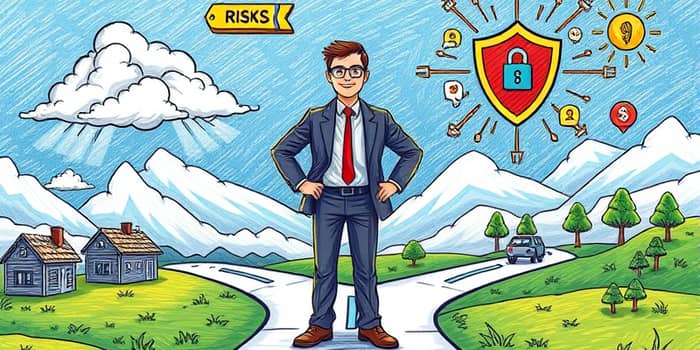In today’s rapidly shifting environment, entrepreneurs face a spectrum of challenges that can make or break their ventures. Adopting robust risk management practices is no longer optional—it’s a strategic imperative.
The Evolving Risk Landscape in 2025
As we move deeper into 2025, entrepreneurs contend with an array of threats, from economic fluctuations to climate events and digital attacks. According to recent studies, economic uncertainty remains the top concern for 73% of firms, with persistent inflation and cost volatility undermining forecasts.
Simultaneously, regulatory changes in data privacy, employment law, and international trade demand agile compliance. Technological risks, especially in cybersecurity, have intensified—highlighted by a surge in incidents attributed to supply chain vulnerabilities.
Building a Proactive Risk Culture
Effective risk management starts with culture. Entrepreneurs must cultivate an environment where teams at every level anticipate and address threats before they escalate.
Begin by integrating risk discussions into regular meetings, encouraging open dialogue about potential vulnerabilities. Document observations in a central, living risk register that assigns ownership and tracks mitigation progress.
Leadership endorsement is crucial. When founders and executives champion risk awareness, employees feel empowered to flag issues and propose solutions without fear.
Leveraging Technology and Innovation
AI and automation have revolutionized risk assessment, enabling real-time monitoring and predictive modeling. Tools powered by machine learning can flag anomalies and forecast trends with remarkable accuracy.
Implement AI-driven tools and RegTech platforms to automate compliance checks, manage vendor due diligence, and streamline reporting. Blockchain solutions also enhance supply chain transparency, reducing the impact of disruptions.
However, technology is not a silver bullet. Pair advanced platforms with human oversight to interpret findings, contextualize alerts, and make strategic decisions.
Practical Frameworks and Strategies
Structured approaches guide entrepreneurs through systematic risk management. Standards like ISO 31000 offer principles and guidelines to identify, assess, and prioritize risks.
- Build a risk-aware culture across all teams
- Employ systematic risk identification methods company-wide
- Document risks in a central, living risk register
- Analyze likelihood and impact for probability-weighted prioritization
- Integrate risk management into strategic planning
- Implement strong internal controls and regular audits
- Allocate budget and resources for top-priority risks
- Use technology to automate, track, and report risks
- Invest in cybersecurity training and infrastructure
- Establish and test crisis and disaster recovery plans
By following these steps, entrepreneurs can move from reactive firefighting to proactive identification and assessment, setting the stage for sustainable growth.
Resource Allocation and Budgeting
Once risks are prioritized, allocate capital and personnel based on severity and likelihood. A dynamic approach revisits funding allocations annually or when major shifts occur in the external environment.
For high-impact vulnerabilities, consider insurance solutions—such as captive insurance—to transfer risk. Regular audits ensure controls remain effective and resources are well-aligned with priorities.
Crisis Communication and Reputation Management
In the face of disruption, transparent communication is your strongest asset. Develop a crisis communication plan that outlines key messages, stakeholder channels, and spokesperson responsibilities.
A prompt, honest response builds trust. When social media amplifies reputational risks, timeliness and consistency in messaging can mitigate fallout and preserve brand integrity.
Scenario Planning and Resilience Building
Scenario planning prepares teams for unforeseen events. Simulate crises—cyber breaches, supply chain breakdowns, or regulatory shocks—to test response protocols and uncover hidden weaknesses.
Stress tests reveal how interconnected risks can cascade. Mapping these interdependencies helps avoid “missed connections” that turn minor issues into existential threats.
Continuous Monitoring and Adaptation
Risk management is not a one-time project. Establish ongoing monitoring processes using analytics dashboards, automated alerts, and periodic reviews.
Adapt strategies in response to new intelligence, shifting from static registers to dynamic risk profiles. This agility enables swift course corrections and keeps enterprises ahead of emerging threats.
Lessons from Recent Disruptions
The 2024 Baltimore Key Bridge collapse exemplifies how infrastructure failures ripple through supply chains, financial systems, and operational networks. Companies that diversified suppliers and invested in real-time monitoring weathered the crisis more effectively.
These case studies underscore the value of scenario planning and contingency strategies and highlight why resilience must be embedded in every business function.
The Path Forward: Embedding Risk in Strategy
Forward-looking entrepreneurs treat risk management as a source of competitive advantage. By weaving risk insights into strategic planning, organizations can spot opportunities that competitors may overlook.
Embrace a mindset that sees uncertainty as a force for innovation. Whether it’s launching new products, entering emerging markets, or reevaluating supply chain configurations, informed risk-taking drives growth.
Key takeaways for entrepreneurs:
- Risk management is a strategic asset, not a checkbox.
- Technology-forward solutions amplify human judgment.
- A risk-aware culture accelerates problem-solving.
- Continuous monitoring enables proactive adaptation.
By combining structured frameworks, innovative technologies, and a culture of vigilance, entrepreneurs can transform uncertainty into opportunity. In 2025 and beyond, risk management will be the cornerstone of sustainable success.
References
- https://www.entrepreneur.com/leadership/these-4-business-risks-lie-ahead-in-2025-heres-how-you/482865
- https://www.fisglobal.com/insights/risk-management-strategies-to-help-tackle-2025-biggest-challenges
- https://useshiny.com/blog/risk-management-strategies/
- https://blog.workday.com/en-us/ai-enterprise-risk-management-what-know-2025.html
- https://community.trustcloud.ai/docs/grc-launchpad/grc-101/risk-management/risk-management-in-2025-building-resilient-strategies/
- https://procurementtactics.com/risk-management-statistics/
- https://auditboard.com/blog/risk-management-101
- https://auditboard.com/blog/risk-management-trends-for-2025-missed-risk-connections-context-and-shifting-dynamics-demand-new-approaches










